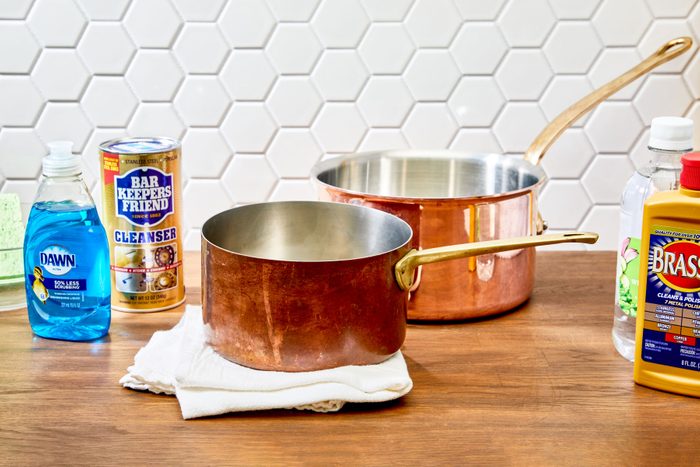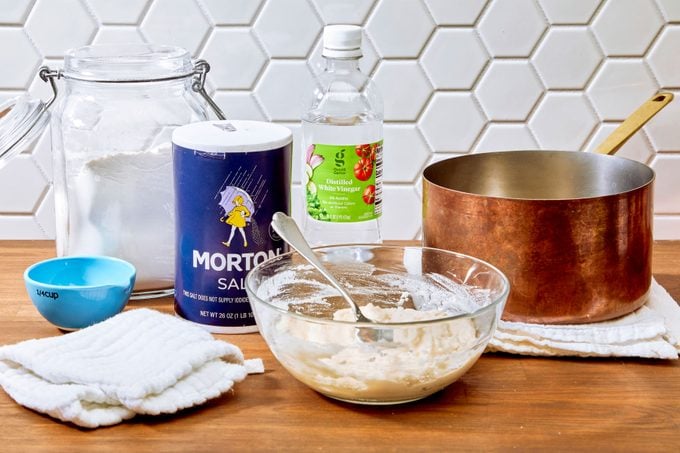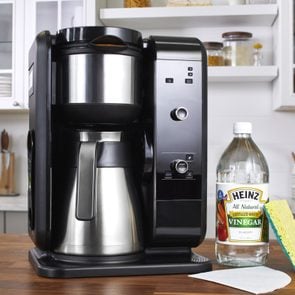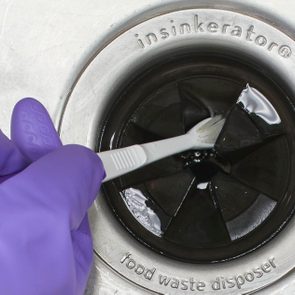How to Clean and Polish Copper to Restore Its Shine
Updated: Sep. 26, 2023

Those gorgeous pots and pans will look brand-new again in no time—as long as you learn how to clean copper the right way
There’s something about copper pots and pans that lures even novice cooks. French culinary purveyor Bill Borman of Piggy Kitchen has been scouring France and selling his vintage copper wares for decades. For him, the history has something to do with it. “People have had their hands on these things for a hundred years,” he says. “Think of the meals that have been made on that!” Even new copper wares have that irresistible old-time feel, and chances are, you’re thinking about the delectable dishes you’ll whip up in them. Your heart says it’s the perfect purchase. Then your head asks: Do you know how to clean copper and retain that warm, lovely finish?
You’re in luck: You can easily fit copper cleaning into your regular cleaning schedule. (And yes, it does need some attention if you want to keep it looking gorgeous.) If you’ve learned how to clean brass and how to clean silver, tackling those copper pots and pans should come just as naturally. Even better, they don’t have nearly as many nooks and crannies as some ornate silver.
The other bit of good news? The more you use copper, the less it needs polishing. If that doesn’t encourage cooking, consider this: With proper maintenance, copper pots and pans offer super heat conductivity and relatively nonstick cooking. With just a few supplies, it will be easy to perform this task when you clean your kitchen, and in many cases, you’ll have to do it far less often than cleaning your stovetop, countertops and floors. Here’s what you need to know about how to clean this gorgeous cookware properly.
Get Reader’s Digest’s Read Up newsletter for more cleaning, humor, travel, tech and fun facts all week long.
Why does copper tarnish?
Over time, copper sinks, pots and pans may lose their luminance. They can also turn spotted, brown or black. This process is called oxidation, and it occurs when air impacts the metal. If water or salt is added to the equation, the metal might turn what’s technically known as verdigris. That greenish color may be charming on a garden gate, but it’s a lot less appealing on a pot. Ironically, oxidation can actually protect the metal underneath, though it’s not a look we appreciate in the kitchen.
Tarnished pots are not a fait accompli, as they say in France. The finish can be restored with gentle acids—some of which may already be in your kitchen.
How often should you clean copper?
A cleaning schedule for copper depends on personal preference and use. But there is a difference between everyday cleaning and polishing. Cleaning removes dust from display pots, as well as debris left from cooking. Borman recommends cleaning anything on display every couple of months. For the kitchen workhorse, he suggests cleaning with a mild soap and sponge after every use. Try to avoid aggressive scrubbing, since this could remove the seasoned (and nonstick!) gray interior and wear away the exterior shine.
Wondering about a copper sink? Gently wash it with soap and water every day, making sure to rinse it completely and then dry it with a soft towel. Avoid scrubbing your sink (and any other copper items) with anything abrasive. Caring for a copper sink is different than cleaning your stainless sink, largely because some foods and liquids can damage it if they aren’t removed.
Every two months or so, check to see if your copper pots are dull or browning. If they are, it’s time to dig deeper in the toolbox for cleaning and/or polishing. Polishing copper removes oxidation and restores the warm, shiny finish. As for a pot’s brass handles, clean them along with the copper base whenever you perform that task.
How to clean copper
At a basic level, cleaning copper pots and pans begins like cleaning any other pot in the kitchen: with soap and water. Whether your copper is new or vintage, hand-wash only! Is there food stuck in the bottom of the pan? Soak, don’t scrub. Fill the vessel with hot water, or even boil water in it on the stove. Just don’t boil an acid like vinegar or lemon juice. These acids are great for restoring shine outside, but you’ll want to keep them away from the inside, since the copper pots and pans are lined with different metals that may be sensitive to acid. For good measure, don’t forget to clean your sponge or replace it after tackling this kitchen project.
How to clean copper with soap and a mild commercial acid

Supplies:
- Dish soap
- Cellulose sponge or other non-abrasive sponge
- Bar Keepers Friend
- Cotton towel
Directions:
- For copper pots, start by rinsing with warm water.
- Add a mild dish soap to a damp sponge, and gently clean. Remember not to scrub the gray lining, often made from tin. The metal, nonstick surface could suffer from overzealous cleaning.
- To reclaim copper’s rosy glow, Borman advises turning the pot upside down and running water over it.
- Sprinkle a little copper-safe cleanser, like Bar Keepers Friend, on the outside of the damp pot, and run your sponge around the outside only.
- Rinse completely, and dry thoroughly with a cotton towel.
Pro tip: Check the finish on your copper before cleaning. Some pots and pans are lacquered, meaning soap and water are the best way to clean them—no polishes or acids necessary. Also make sure to remove any drops of water that can lead to spots or corrosion.
How to clean copper with flour and vinegar

Supplies:
- Flour
- Salt
- Distilled white vinegar
- White T-shirt or rag
- Cotton towel
Directions:
Acids like vinegar help remove copper tarnish, and flour gives it sticking power without too much risk of scratching the metal. With that in mind, follow these steps.
- Start by cleaning the copper pot inside and out with mild dish soap and water.
- In a separate bowl, combine 1/4 cup flour and 1/4 cup salt. Add more, proportionally, depending on the size of the item you’re cleaning.
- While stirring, slowly add enough vinegar to make a paste.
- On the outside only, use a dry rag to gently rub the paste onto the copper to dissolve the tarnish. The rag may start to darken if it’s pulling tarnish off. The rosy glow says the solution is working.
- If a few spots remain, try again or consider a commercial product.
- Rinse and dry thoroughly.
Pro tip: Avoid soaking copper in acids like vinegar for any length of time. While vinegar can be used for cleaning and restoring copper’s shine, long exposure can pit the metal. The mixture should be applied only on the outside of the pot or pan for reviving shine.
How to clean copper with lemon juice and cornstarch

Supplies:
- Lemon juice
- Cornstarch
- Salt
- White cotton cloth or microfiber cloth
Directions:
Both vinegar and lemon juice are great organic options for restoring copper’s glory, but lemon juice, with its low pH level, is an even more potent cleansing acid. Like other copper cleaners, use lemon on the outside of the pot or pan only. Cornstarch and salt, which can be gritty, should also be reserved for the exterior.
- Wash inside and out with dish soap and a sponge to remove dirt and debris.
- In a separate bowl, combine equal parts cornstarch and salt. Depending on the size of your item, try a couple of tablespoons each of cornstarch and salt.
- Add just enough lemon juice for a paste-like consistency.
- Wipe the paste onto the copper with a cloth.
- After it is covered completely, wash and dry thoroughly.
Pro tip: Don’t have cornstarch? Don’t worry! While the cornstarch offers a relatively non-abrasive way to create a homemade paste, salt and lemon can do the trick on their own, says Leslie Reichert, a green cleaning expert and the author of The Joy of Green Cleaning. Simply cut the lemon in half, and press it into a mound of salt. Then scrub the copper exterior. The salt combines with the acid from the lemon to dissolve the oxidation with a little scrubbing. Rinse, and dry completely.
In case you were wondering, here’s the right way to wash a microfiber cloth to preserve its cleaning power.
How to clean copper with ketchup

Supplies:
- Ketchup
- Rag or non-abrasive sponge
- White towel
Directions:
That’s right—you can clean copper with ketchup. It contains grime-fighting acid from tomatoes and salt, and acids plus salt equals a chemical reaction that works to dissolve oxidation.
- Using a sponge or rag, cover the copper with a thin layer of ketchup.
- Rub gently to restore shine.
- Rinse thoroughly, and dry completely.
Pro tip: As a matter of home economics, neither the brand nor age of the ketchup will matter when cleaning copper. Shop based on price, or use the dregs from a long-opened bottle.
How to clean copper with vinegar and salt

Supplies:
- White vinegar
- Salt
- Clean rag or cloth
- Cotton towel
Directions:
- Dissolve 1 tablespoon salt in 1 cup vinegar. Make sure it’s fully dissolved, since salt can be abrasive.
- Apply the mixture to the outside copper with a cotton rag or cloth. Let it sit for up to 30 minutes. Avoid cleaning the interior with this mixture.
- Rinse well, and dry.
Pro tip: For smaller items and as an alternative to the method above, try boiling away tarnish. Add the dissolved salt-and-vinegar solution to 3 cups of water in a larger pot. Submerge the copper item in the liquid, and bring to a boil. Keep boiling until the tarnish dissolves. Let cool in the pot. Once cool, remove it and wash it well with mild soap and water. Dry thoroughly. If some tarnish remains, try another all-natural method or commercial cleaner.
How to clean copper with copper cleaners

If you’d rather mine the hardware store than the pantry, there are a few products that can help clean copper. As always, start by washing and drying the objects to remove as much grime as possible. Also note that copper cleaners are for the copper exteriors only.
Supplies:
- Wright’s Copper Cream
- Brasso Metal Polish
- Clean rag or cellulose sponge
- Cotton towels
- Nitrile gloves or other rubber gloves
Directions for Wright’s Copper Cream:
- Before using, put on rubber gloves to protect your hands.
- Wash the pot under warm water, then dry it.
- Next, apply the cream using the self-enclosed sponge, your own sponge or a damp towel.
- Rinse off residual cream.
- Dry and buff with a separate clean towel.
Directions for Brasso Metal Polish:
- With a clean, dry towel, apply Brasso to the copper.
- Let sit for up to 20 minutes, but buff it off with a separate clean cloth before it’s completely dry.
- If you’re using it on a pot or pan you cook with, wash it again with gentle dish soap.
- Dry it fully before putting it away.
Pro tips: It’s always best to test a product before using it on your entire item. Also make sure to shake any liquid copper cleaners before use in case the solids have settled.
Try to avoid having the tarnished cleaning cloth touch the cleaning product so it stays free of debris. Wet cloths and sponges covered in tarnish tend to leak a little tarnish into containers. Additionally, turn the cloth often as it becomes dirty.
The best copper cleaners
Can you clean badly tarnished copper?
It is possible to restore most copper, according to Piggy Kitchen’s Borman. Knowing whether the pot has been lacquered is critical when determining how to proceed. A badly damaged pot that is lacquered may need an additional step to remove that finish before deep-cleaning. Acetone is one product that can help with that. Once the lacquer is removed, reapply a new copper-specific lacquer after cleaning, or don’t, if a natural finish is preferred.
If an unlacquered copper pot is completely dark, a good soap-and-sponge cleaning comes first. Try submerging the entire pot in a stockpot filled with 4 ounces of baking soda (half a box) and 3 gallons of water. Bring that to a boil. Exhaust the less-invasive possibilities to dissolve tarnish first, but pros might reach for a more abrasive 3M sponge pad. If a pot is unusable, the abrasive pad could restore the shine, though there is a risk of scratching the newly exposed copper. For cleaning a burnt pot other than copper, start with the same least-abrasive approach.
Of course, a professional refinisher can also help both inside and out. Older copper pots lined with tin may even need a separate procedure to resurface the interiors so you can cook safely with them.
How can you keep copper shiny?
Believe it or not, regular use keeps copper shiny, so your first line of defense is to keep cooking! Follow up by using mild dish soap and water after every use, then drying thoroughly. Even pieces sitting on shelves can gather dust and kitchen grime, so give them a bath every couple of months if they’re not in the cooking rotation.
Other caveats:
- Do not preheat or put an empty copper pot or pan on the stove. Something needs to be in the pan to absorb the heat, or the lining could get damaged.
- Use a wooden spoon or coated Teflon spatula for stirring. Metal cooking instruments can scratch and damage the pot lining.
- Avoid abrasive cleaners (like Comet) and scrub brushes. Use only copper-specific commercial products and gentle sponges.
- Dry copper completely before storing.
Finally, make peace with some patina. As Borman says, it will remind you of wonderful meals you’ve cooked—or for vintage pots, the romance of meals that predate you.
Now that you’ve mastered copper cleaning, learn how to clean a wooden cutting board to how to clean a toaster the right way.
Sources:
- Bill Borman, owner of Piggy Kitchen
- Leslie Reichert, green cleaning expert and author of The Joy of Green Cleaning
- Sciencing: “What Causes Copper to Tarnish?”
- Copper Utensils: “What Are the Best Chemicals to Clean Copper?”
- Elkay: “Copper Hammered Sinks (Clean & Care)”


























